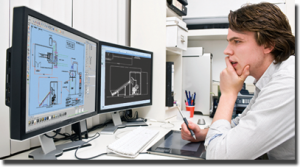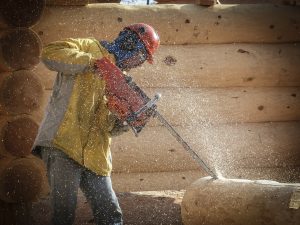The Benefits of a CAD Designed Oak Frames
30th August 2016Gone are the days of chipping away at timber by hand to create an oak frame; as technology has advanced, so have our methods of construction. Here at Carvalo we use cutting edge technology to design and manufacture oak frames, ensuring perfect craftsmanship and very precise measurements.
In this month’s article, we’re looking at our stages of production, using CAD to design oak frames and CNC to cut the timber, and the benefits of working in this way.
Stage 1: CAD designing
 The first step in creating an oak structure is to conceptualise the shape, size, design elements and structural integrity of the intended build. By using the computer software CAD (computer-aided design), high quality drawings of the structure can be created which give accurate insight into the specifications of the building, where the supporting joists will be and how the space will look and function. This is done joint by joint to ensure that when it comes to construction, the frame will fit together flawlessly. By using CAD to design the structure, clients can be shown exactly how their build will be, allowing for any minor adjustments to the design to be done before construction has started.
The first step in creating an oak structure is to conceptualise the shape, size, design elements and structural integrity of the intended build. By using the computer software CAD (computer-aided design), high quality drawings of the structure can be created which give accurate insight into the specifications of the building, where the supporting joists will be and how the space will look and function. This is done joint by joint to ensure that when it comes to construction, the frame will fit together flawlessly. By using CAD to design the structure, clients can be shown exactly how their build will be, allowing for any minor adjustments to the design to be done before construction has started.
Stage 2: Structural approval
After the design has been produced, it is handed over to our expert engineers for structural approval. This system allows our engineers to analyse the strength of the structure fully before a single piece of timber has been touched, so our clients can have every confidence in the longevity of the structure.
Stage 3: Preparing the timber
Once the design stage is over, the timber is ordered. When using a CAD design, we have a reliable estimation of the amount of timber needed, reducing the likelihood of timber wastage or under-ordering supplies. Once the timber is delivered, it is planed down to produce a faultless finish that is aesthetically attractive.
Stage 4: CNC cutting
The CAD file is then transferred to our CNC machine which cuts the timber down to the exact components required for the project. To make things even easier, the CNC system numbers each piece so that when we deliver the wood to site, we simply need to match the numbered timber to its corresponding place on the installation plan.
Stage 5: Constructed
Finally, the frame is ready to be put together. High quality construction tools are used to ensure strong joints and a long-lasting frame, but this process takes very little time now, thanks to the CNC machine taking care of all the cutting and organising of the timber; it is simply a matter of putting the components in the right order.
The benefits of the CAD and CNC systems
Using technology in construction is really beneficial to both the customer and the contractor, with benefits of the CAD and CNC systems including:
- Highly accurate measurements
- Ability to fully conceptualise the structure prior to build
- Certified structural integrity before construction
- Quicker construction times
- Less room for human error
- No wasting materials by overestimating requirements
- Timber is guaranteed to be cut to the precise measurements
- Reduces costs as there is less material wastage and the construction takes less time and man hours.
Carvalo have over 10 years’ experience in the design, production and installation of high quality, beautiful oak structures. We focus on an impeccable level of craftsmanship to ensure that not only are all of our structures aesthetically pleasing, but that they are robust and strong, guaranteed to last many years. Whether you’re looking for a bespoke stable, conservatory, garage or any other creation, look no further than our team here at Carvalo for a reliable service, every time.
For more details on this or any of our other services, get in contact today and we’ll be happy to offer our assistance.
This entry was posted in Construction. Bookmark the permalink. ← Conservatory Planning Permission Follow
Follow